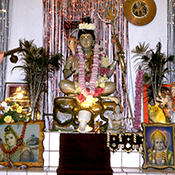 The Hindu tradition acknowledges different forms and representations of the divine, all understood in their relation to the supreme being, Brahman. In a single temple, for example, there may be a central sanctum dedicated to Shiva or Vishnu along with auxiliary shrines to different deities.
The Hindu tradition acknowledges different forms and representations of the divine, all understood in their relation to the supreme being, Brahman. In a single temple, for example, there may be a central sanctum dedicated to Shiva or Vishnu along with auxiliary shrines to different deities.
View full album
For outsiders, the most striking evidence of Hindu diversity is the multiplicity of Gods. There are those with a specific area of jurisdiction for which the word “god” with a small “g” might be appropriate, and there are those of such all-embracing supremacy that only the term “God” with a capital “G” will do. In any Hindu temple there are likely to be many divine images, or murtis, even though the central image may be of a particular God, a form of Shiva, the Goddess, or Vishnu. In a temple of Shiva, for example, the central sanctum will contain a Shiva linga, a simple stone shaft, where offerings of flowers, sweets, grains, and water may be presented. Surrounding this central sanctum, however, there may be a dozen subsidiary shrines to various deities. To one side of Shiva might be the image of his son Ganesha, the elephant-headed god. On the other, there might be the image of another son, Murugan, also known as Skanda or Karttikeya. Elsewhere there might be shrines dedicated to Lord Rama, with his wife Sita at his side. There might be an image of the River Ganges, personified and bearing a brimming pot of sacred waters. There might be an image of Lord Krishna, playing the flute and attracting all who hear with its amorous melody.
The Hindu tradition has made a point of articulating the diversity and plurality of the Gods. There are many Gods. And there are many names and forms of each God. But any worshipper would insist that this manyness must be understood in relation to God’s oneness. The sages of old used the term Brahman to describe the Reality that transcends all personal names. Brahman is one, though the “names and forms” of this one are different. This one Reality—call it Brahman, the Divine, or the Real—can be perceived in and through an infinite number of names and forms. The Rig Veda affirms, “Reality is One. The sages speak of it in many ways.” This idea is sounded repeatedly throughout the whole history of Hinduism. Even today, as a young Hindu woman put it, describing the images at the Ganesha Temple in Nashville, Tennessee, “All these murtis are different representations of the one Supreme Being—each with its own personality and attributes.”